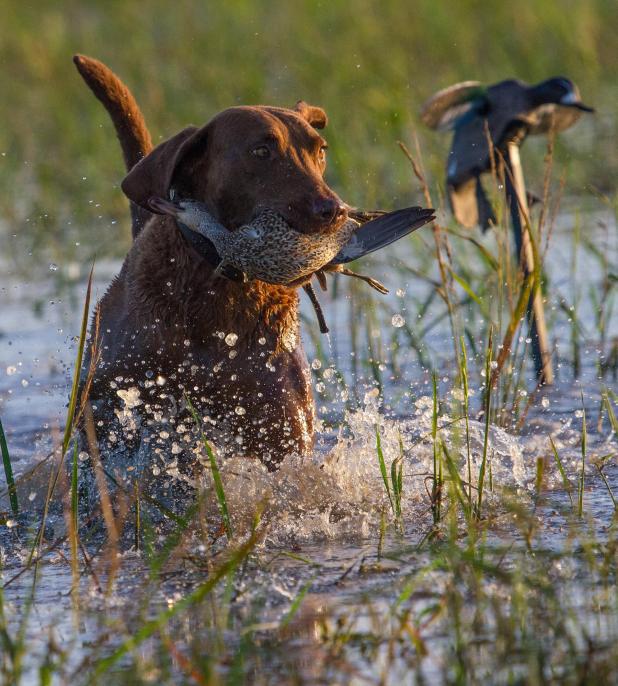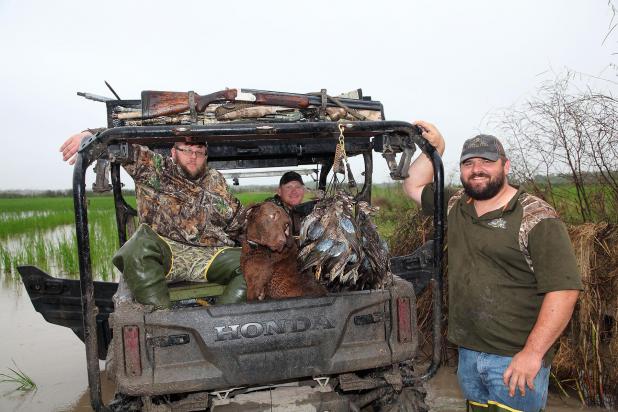
A Chesapeake Bay Retriever returns from a blue winged teal retrieve.
The Daily Review/John Flores

This group of hunters from Hayes had a big day in the rice fields of southwest Louisiana.
As teal season approaches, key survey gets canceled
When some 92,000 Louisiana waterfowl hunters go to the marsh and rice fields next weekend (Sept. 12) to hunt teal, it won’t be without some reservations.
After all, for the first time in 65 years the United States Fish and Wildlife Service canceled its spring Waterfowl Breeding Population and Habitat Survey due to the COVID-19 virus.
The annual waterfowl survey happens to be the most extensive scientific wildlife study in the world, covering some 2.1 million square miles of real estate in both the United States and Canada. The survey is designed to gather information and data on population trends, distribution and habitat use.
It’s also the biggest piece of information that every avid waterfowl hunter looks forward to in anticipation of the upcoming season. The past two years, where Blue Winged Teal are concerned, those breeding numbers reflected 6.45 million teal in 2018 and 5.43 million teal in 2019 that would make baby teal. Great news for waterfowl faithful.
Unfortunately, the past two years were near busts for many of Louisiana’s early season teal hunters and September aerial surveys reflected that. Just prior to the 2018 opener, Louisiana Department of Wildlife and Fisheries biologists flew their annual Waterfowl Population Estimate in the state’s coastal zone and Catahoula Lake. The outcome reflected an estimated 59,000 Blue Winged Teal in the state.
The numbers were 84% lower than the previous year, 32% below the most recent 5-year average, 75% below the state’s long term average, and the second lowest estimate on record.
The 2019 September survey was better, but not a shining example of the Sportsman’s Paradise by any stretch of the imagination. Essentially, last year’s reported estimate of 127,000 Blue Winged Teal were 20% below the most recent 5-year average of 158,000 and 45% below the long-term average of 230,000. And, most of those birds were counted in Southwest Louisiana.
The opening day Hunter Participation/ Harvest Summary issued by the LDWF from bag checks on coastal wildlife management areas was not pretty. The 98 “actual” number of hunters checked on the Atchafalaya Delta WMA here in St. Mary Parish revealed a paltry 1.5 Blue Winged Teal killed per hunter.
The grand total of three coastal WMAs (Atchafalaya Delta, Pass a Loutre and Point aux Chene) was 1.1 teal per hunter. Bear in mind, of those 127,000 teal counted during the aerial survey, only 12,000 were estimated in the southeast transects. There’s a lot of marsh and water from Vermilion Bay to the Biloxi Marsh WMA east of New Orleans.
So, where do we stand heading into next week’s September teal season? LDWF Waterfowl Program Manager Larry Reynolds says all we have is the North Dakota breeding population survey this year.
Reynolds said, “The North Dakota survey has been ongoing since 1948, and this year, ponds were up 65% from 2019 and 70% over the long term average. Ducks were up 18% from 2019 and 64%t above the long-term average. Blue Winged Teal were up 58% from 2019. There was great water in North Dakota and as a result, a lot of ducks stopped there to breed. Typically, when there is good water on the southern end of the breeding grounds, ducks will stop there and have good reproductive success.”
Anecdotally, Reynolds mentioned that there has been limited banding in Canada this year due to the COVID pandemic. However, on a few sites in both southern Saskatchewan and Manitoba, there have been a “pesky” number of immature Blue Winged Teal.
“Pesky, because the goal of this limited banding is to focus on mallards to generate the data necessary to run the adaptive management harvest process for setting overall duck seasons, and the number of blue wings made it difficult. The same was true for some banding sites in North and South Dakota. So, there is some suggesting that at least blue wings had good reproductive success,” Reynolds said.
A good video on You Tube to watch is Delta Waterfowl’s “Fall Flight 2020 Outlook.” Dr. Frank Rohwer, President and Chief Scientist for Delta Waterfowl along with Matt Chouniard, Senior Waterfowl Program and Delta Marsh Property Manager, in 4½ minutes expound upon the duck numbers and water conditions across Canada. By all indications, much of the “Duck Factory” for the Mississippi and Central Flyways, both north and south of the US border with Canada has received above average moisture with a few exceptions.
What impact Hurricane Laura will have on the Blue Winged Teal September Season remains to be seen. One of the more popular outings at this time of year is to do what’s known as a “blast and cast,” where hunters make an early morning hunt for teal and follow it up with a speckled trout fishing trip.
Prior to the storm, Reynolds says there were reports coming in with people seeing more Blue Winged Teal than normal showing up. Moreover, some of the department’s banders reported more Blue Winged Teal being captured during their Wood Duck banding operations than in past years.
Unfortunately, a number of outfitters around Hackberry, Creole, Little Chenier, and elsewhere across southwest Louisiana suffered severe losses that will greatly impact their business this season.
If you live in Louisiana long enough, one thing you’ll learn is that the people here are pretty resilient. As such, I have a feeling when next Saturday’s September teal season opens, there will be quite a few people taking a break from the endless monotony of hurricane cleanup and repair to shoot a few teal. And God Bless them. They deserve it.
